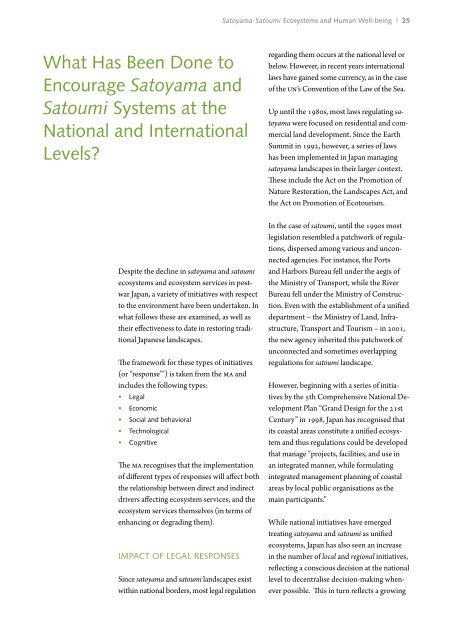Satoyama-Satoumi Ecosystems and Human Well-Being - UNU-IAS ...
Satoyama-Satoumi Ecosystems and Human Well-Being - UNU-IAS ...
Satoyama-Satoumi Ecosystems and Human Well-Being - UNU-IAS ...
Create successful ePaper yourself
Turn your PDF publications into a flip-book with our unique Google optimized e-Paper software.
<strong>Satoyama</strong>-<strong>Satoumi</strong> <strong>Ecosystems</strong> <strong>and</strong> <strong>Human</strong> <strong>Well</strong>-being | 25<br />
What Has Been Done to<br />
Encourage <strong>Satoyama</strong> <strong>and</strong><br />
<strong>Satoumi</strong> Systems at the<br />
National <strong>and</strong> International<br />
Levels?<br />
Despite the decline in satoyama <strong>and</strong> satoumi<br />
ecosystems <strong>and</strong> ecosystem services in postwar<br />
Japan, a variety of initiatives with respect<br />
to the environment have been undertaken. In<br />
what follows these are examined, as well as<br />
their effectiveness to date in restoring traditional<br />
Japanese l<strong>and</strong>scapes.<br />
The framework for these types of initiatives<br />
(or “response”’) is taken from the MA <strong>and</strong><br />
includes the following types:<br />
•• Legal<br />
•• Economic<br />
•• Social <strong>and</strong> behavioral<br />
•• Technological<br />
•• Cognitive<br />
The MA recognises that the implementation<br />
of different types of responses will affect both<br />
the relationship between direct <strong>and</strong> indirect<br />
drivers affecting ecosystem services, <strong>and</strong> the<br />
ecosystem services themselves (in terms of<br />
enhancing or degrading them).<br />
Impact of legal responses<br />
Since satoyama <strong>and</strong> satoumi l<strong>and</strong>scapes exist<br />
within national borders, most legal regulation<br />
regarding them occurs at the national level or<br />
below. However, in recent years international<br />
laws have gained some currency, as in the case<br />
of the UN’s Convention of the Law of the Sea.<br />
Up until the 1980s, most laws regulating satoyama<br />
were focused on residential <strong>and</strong> commercial<br />
l<strong>and</strong> development. Since the Earth<br />
Summit in 1992, however, a series of laws<br />
has been implemented in Japan managing<br />
satoyama l<strong>and</strong>scapes in their larger context.<br />
These include the Act on the Promotion of<br />
Nature Restoration, the L<strong>and</strong>scapes Act, <strong>and</strong><br />
the Act on Promotion of Ecotourism.<br />
In the case of satoumi, until the 1990s most<br />
legislation resembled a patchwork of regulations,<br />
dispersed among various <strong>and</strong> unconnected<br />
agencies. For instance, the Ports<br />
<strong>and</strong> Harbors Bureau fell under the aegis of<br />
the Ministry of Transport, while the River<br />
Bureau fell under the Ministry of Construction.<br />
Even with the establishment of a unified<br />
department – the Ministry of L<strong>and</strong>, Infrastructure,<br />
Transport <strong>and</strong> Tourism – in 2001,<br />
the new agency inherited this patchwork of<br />
unconnected <strong>and</strong> sometimes overlapping<br />
regulations for satoumi l<strong>and</strong>scape.<br />
However, beginning with a series of initiatives<br />
by the 5th Comprehensive National Development<br />
Plan “Gr<strong>and</strong> Design for the 21st<br />
Century” in 1998, Japan has recognised that<br />
its coastal areas constitute a unified ecosystem<br />
<strong>and</strong> thus regulations could be developed<br />
that manage “projects, facilities, <strong>and</strong> use in<br />
an integrated manner, while formulating<br />
integrated management planning of coastal<br />
areas by local public organisations as the<br />
main participants.”<br />
While national initiatives have emerged<br />
treating satoyama <strong>and</strong> satoumi as unified<br />
ecosystems, Japan has also seen an increase<br />
in the number of local <strong>and</strong> regional initiatives,<br />
reflecting a conscious decision at the national<br />
level to decentralise decision-making whenever<br />
possible. This in turn reflects a growing
















